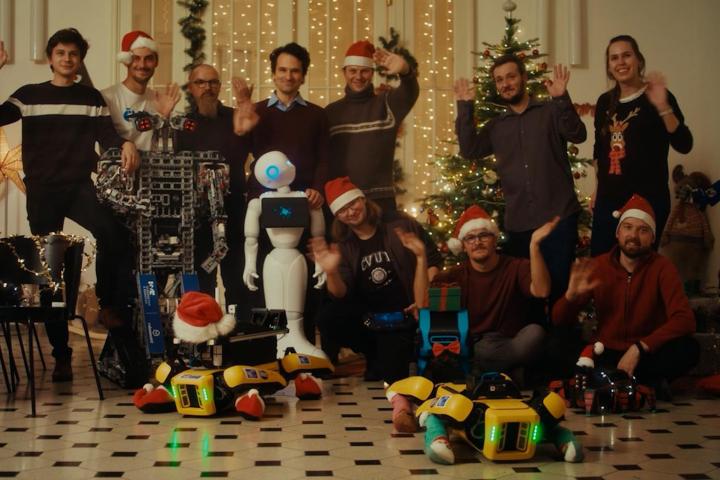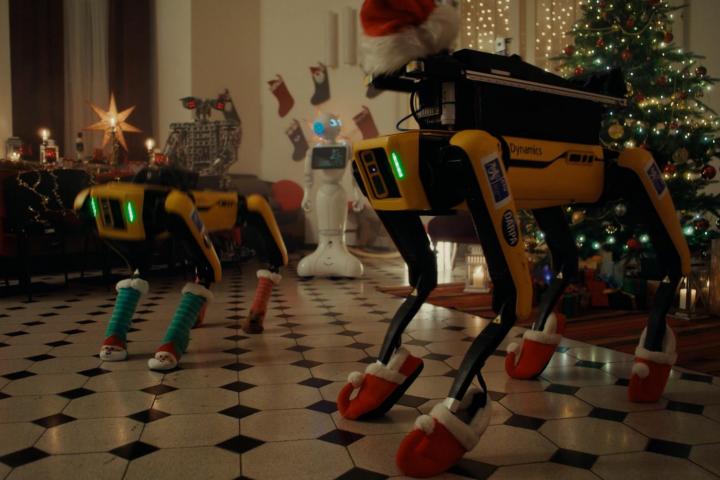
You can watch the FEE CTU Christmas video via the link.
The creators tried to show the best that the Faculty of Electrical Engineering of CTU has to offer in the field of robotics in the video entitled "A Happy and Merry Christmas from the robotic crib". They managed to bring robots from several scientific departments - Vision for Robots and Autonomous Systems and Multirobotic Systems (both at the Department of Cybernetics), the Artificial Intelligence Centre (AIC) at the Department of Computer Science and the Department of Control Engineering, including the Robocompetition - to the Christmas tree placed in the foyer of the Zenger Lecture Hall at Charles Square.
All of these departments scored remarkable success in 2021. Here are some of the most significant: The CTU-CRAS-NORLAB team, composed of researchers from the Department of Cybernetics and the Department of Computer Science, successfully competed against the best teams in the world in the DARPA Subterreanean Challenge, which is considered the "Robotics Olympics" due to its prestige. Drones from the Multirobotic Systems Group represented Czech science and research at the World EXPO. The Department of Control Engineering presented the balancing robot SK80 (read Skejto) and robotic keys, but also resumed, after a year-long covid break, the organization of Robocompetition, the largest domestic competition in programming and construction of LEGO robots for students from secondary and primary schools. The Humanoid Robotics Group introduced a new robot, iCub, which opens up new possibilities for exploring the human brain with its electronic skin.
The video was produced by baohaus producer Oliver McGillick and directed by Oliver Beaujard and Nina Zardalishvili. The director of photography was Daniel Hotový. "Directing robots was an interesting experience and we have to say that when you tune in to the limits of the possibilities of acting, they are quite easy to direct. We rate this project as successful, our goal was to make a video that exudes the Christmas spirit right away, and we hope we managed that," Oliver Beaujard and Nina Zardalishvili from the directing duo bao-bab summed up the experience of filming at CTU’s Faculty of Electrical Engineering.
The story of the video toys with the autonomous behavior of robots. Although robots are making progress in terms of their autonomy thanks to the work of computer scientists from FEE CTU, they are still far from celebrating Christmas "autonomously". Their movements and dancing are facilitated by hours of work by their programmers and operators. An example is the humanoid robot Pepper, who imitates playing the whistle in the video and whose movements had to be programmed.
The video features:
Walking robots SPOT, Scarab, Daisy
Crawler robot Charlie
Wheel robot Husky
Balancing robot SK80
Humanoid robots iCub, Pepper, Nao and Louis assembled from LEGO
Drone X500, quadcopter for indoor flights
LEGO robot playing the keys
The robots from Charles Square featured in the video can also be seen by the public. The nearest opportunity for those interested in studying at FEE CTU is an open house scheduled for Friday, 3 December 2021, when it will be possible to see the laboratories that contributed to the making of the Christmas video.
In the year that marks 70 years since its foundation, however, the Faculty of Electrical Engineering of CTU, is definitely not focused solely on robots. The Faculty is developing cutting-edge research into technological trends that will affect the way we work, travel, spend our leisure time and live in the future. From telecommunication networks and alternative energy sources to artificial intelligence and bioinformatics to cybersecurity and space technologies, all these future phenomena can be researched and studied at FEE. The Faculty contributes one third to the overall scientific output of the CTU, measured by impacted publications and citations, and its share of cutting-edge publications and foreign patents exceeds 40 percent.
Photo, source: Faculty of Electrical Engineering CTU

